Physical Address
304 North Cardinal St.
Dorchester Center, MA 02124
Proper management of trauma patients requires early recognition of spinal trauma to minimize the potential catastrophic sequelae of undetected or underestimated injuries of the spinal column. The epidemiology of spine trauma can be difficult to quantify because most population-level estimates are extrapolations of inpatient or emergency room discharge databases, which rely on accurate diagnosis coding and geographic representations. Furthermore, many spinal cord injury (SCI) patients die before arrival at a healthcare facility, which further underestimates the actual incidence. Recognizing these shortcomings, it has been reported that approximately 50,000 spinal column fractures occur in the United States each year, and the incidence appears to be rising. This increase is thought to be due in large part to an aging population and the associated increase of osteoporotic or fragility fractures seen in the elderly.
Most spine fractures occur at the proximal and distal junctions of the rigid thoracic cage. Spinal column fractures resulting in a SCI can be devastating. Globally, 250,000 to 500,000 SCIs occur each year. Although many spinal injuries occur before contact with healthcare providers, proper management can help prevent further neurologic injury. To optimize the care of trauma patients, a thorough understanding of appropriate evaluation and management algorithms, as well as the evidence behind those recommendations, is needed. This chapter reviews the principles of the evaluation of spinal trauma patients.
All trauma patients are presumed to have a spinal injury.
The initial evaluation and management of trauma patients should follow the Advanced Trauma Life Support (ATLS) guidelines.
After the airway is secured and immediate life-threatening conditions are ruled out, the spinal and neurologic examinations are a crucial component of the secondary survey.
Cervical spine clearance is a systematic process to exclude clinically significant spinal injury that may lead to neurologic injury.
For cervical spine clearance, patients are classified into four groups based on their mental status: alert and asymptomatic; short-term cognitive impairment; symptomatic; and long-term cognitive impairment. Each group is evaluated using a specific algorithm, although controversies exist on best methods.
For evaluation of the thoracolumbar spine, computed tomography (CT) scans obtained during the trauma workup are sensitive for detecting thoracolumbar injuries.
Asymptomatic patients sustaining low-energy trauma can have thoracolumbar spine clearance by examination if alert and without distracting injuries or other spinal fractures.
All blunt trauma patients are presumed to have a spinal injury until proven otherwise, and appropriate management of these patients requires the close cooperation of multiple disciplines, including emergency medicine, general surgery, neurosurgery, orthopaedic surgery, radiology, and critical care specialists. Vigilant adherence to spinal precautions during the initial evaluation and resuscitation is crucial to prevent neurologic injury or exacerbate existing neurologic damage. SCIs, especially those associated with vehicular crashes, are commonly accompanied by other injuries, including loss of consciousness (43%), fractures of the trunk or long bones (40%), head injury (18%), and pneumothorax (17%). Because SCI is commonly associated with other severe and life-threatening injuries, proper protocols must be followed to ensure that the patient is cared for thoroughly and properly.
The initial evaluation and management of trauma patients takes place in the field with first responders and continues en route and upon presentation to the hospital. The goal of treatment is to preserve life, limb, and function. The American College of Surgeons has established Advanced Trauma Life Support (ATLS) protocols for the initial assessment, resuscitation, and stabilization of trauma patients. These protocols are designed to systematically evaluate and identify life-threatening injuries while maintaining precautions necessary to prevent further harm to the patient. Occult spinal injuries may not be immediately recognized because the initial focus centers on the cardiopulmonary systems.
All trauma patients should be treated as though they have sustained an unstable spinal column injury until proper evaluation has proven the lack of an unstable injury. In fact, reports estimate that as many as 25% of patients with traumatic spine injuries experience neurologic deterioration after coming under the care of medical personnel. As a result, provisional stabilization and appropriate immobilization of the spine starting at the scene are crucial for preventing the onset of a neurologic injury or avoiding exacerbation of an existing neurologic injury. This entails maintaining the head and neck in alignment with the long axis of the trunk and keeping the neck from abnormal flexion or extension.
Emergency medical technicians are often the first responders after a traumatic event and are tasked with making critical observations and clinical judgments before handing treatment over to clinicians at the hospital. If the patient is unresponsive, a spine injury should be presumed and factored into any intervention performed in the field or at the hospital. If the patient is able to communicate, an inquiry regarding the mechanism of injury and any neurologic symptoms can be helpful (although the mental status may be tenuous). Accurate documentation of the patient's initial mental status at the scene is helpful because it provides a baseline for providers in hospital facilities.
The Glasgow Coma Scale (GCS) is an efficient and reliable way to communicate a patient's alertness, orientation, and motor response. More importantly, it can be trended throughout a patient's evaluation and treatment. The score is based on the patient's best eye response, verbal response, and motor response to verbal commands or painful stimuli. Scores range from 3 to 15, with a GCS score of 15 corresponding to a patient who is awake, alert, appropriate, and following commands by demonstrating active motor function. A GCS score of 13 or 14 represents mild brain injury, a score of 9 to 12 corresponds to moderate brain injury, and a score of 8 or less is indicative of severe brain injury ( Table 11.1 ). The GCS score upon evaluation is inversely correlated to the probability of a cervical spine injury. Although the motor response portion of the GCS provides a gross assessment of the corticospinal tract integrity, it does not obviate the need for a more thorough examination of individual muscle groups, dermatomes, and spinal reflexes.
| Behavior | Response | Score |
|---|---|---|
| Eye opening | Spontaneously | 4 |
| To verbal command, speech or shout | 3 | |
| To pain | 2 | |
| No response | 1 | |
| Verbal | Oriented | 5 |
| Conversant but confused | 4 | |
| Inappropriate response | 3 | |
| Words incomprehensible | 2 | |
| No response | 1 | |
| Motor | Obeys commands | 6 |
| Purposeful movement to stimulus | 5 | |
| Withdraws to pain | 4 | |
| Abnormal flexion, decorticate posture | 3 | |
| Abnormal extension, decerebrate posture | 2 | |
| No response | 1 |
One essential task of emergency medical technicians is the immobilization of the spine in the field. In the past, the prescribed practice has been to routinely “board and collar” all blunt trauma patients. Unfortunately, the use of the backboard does not come without potential harm to the patient, including worsening pain, pressure sores, and impaired respiration, especially with prolonged use. As a result, there has been a recent effort to stratify the patients who actually require such immobilization. In fact, the National Association of Emergency Medical Services Physicians (NAEMSP) and the American College of Surgeons Committee on Trauma recently recommended a long backboard for the immobilization of the spine in blunt trauma patients with obvious spinal deformity, neurologic complaints, spinal tenderness, or altered consciousness, but not those with a GCS of 15 without any of those findings.
In the past, the accepted method for moving a patient onto and off a spine board was the logroll maneuver. However, recent research has shown that this technique results in significantly more cervical, thoracic, and lumbar motion than other available techniques, such as the scoop stretcher, straddle lift and slide, and 6+ lift and slide methods. As a result, some authors recommend using one of these alternative techniques rather than logrolling when transferring trauma patients. The one exception is when a patient is found prone at the scene; he or she should be transferred directly onto a spine board using the logroll push technique. After the patient is positioned on a flat, rigid spine board, sandbags are placed on either side of the head and neck, and the head is taped to the board to adequately immobilize the spine. Of note, children have disproportionately larger heads; therefore elevating the trunk on padding or using special pediatric spine boards equipped with a recessed head section is needed to prevent potentially dangerous neck flexion.
The currently accepted practice for the management of potential cervical trauma is to apply a rigid cervical collar to help immobilize the cervical spine in the neutral position before extrication from the accident scene, but there is an ongoing movement to limit the immediate application of cervical spine collars placed in the field. This is due to the time it takes to apply a cervical orthosis properly and safely, which can delay definitive care. In fact, Horodyski et al. demonstrated that cervical collars did not reduce motion in a cadaveric cervical spine injury model, especially during transfers. Furthermore, Sundstrom et al. concluded that routine cervical collars may exacerbate existing injuries. Additionally, the sustained immobilization with a field collar is associated with an increased aspiration and delirium risk, especially notable in the geriatric population. The standard practice to use cervical collars in all blunt trauma patients has been challenged recently, much like the backboard, due to the recognized potential harms of collar application and wear. The authors recommend the criteria outlined by the NAEMSP for backboard use and forgoing collar use for patients with a low-energy mechanism of trauma who have a GCS of 15 without neck tenderness, neck pain with movement, and transient or current neurologic symptoms.
Early communication between first responders and the hospital emergency department (ED) is important to ensure that the proper personnel and resources are present as soon as the trauma patient arrives. In 2013, the Congress of Neurologic Surgeons recommended expeditious transfer of acute spinal cord injuries to definitive care facilities in consideration of the distance to the nearest definitive facility and the patient's clinical circumstance. The ATLS protocol was developed to systematically evaluate patients in an efficient manner, reduce missed injuries, and rapidly institute lifesaving interventions. Upon arrival, the first priority of the ATLS protocol involves the initiation of the “primary survey” following the mnemonic “ABCDE,” which corresponds to airway, breathing, circulation, disability (i.e., neurologic status), and exposure (i.e., completely undress the patient). It is essential to ensure proper spine immobilization and spinal precautions during the entire process. Furthermore, although emergency responders in the United States are trained to assess the cervical spine at the trauma scene and immobilize as needed, their assessment should be confirmed and further examined.
The initial step in the ATLS protocol primary survey is airway assessment. Of note, although spine injuries are rarely implicated in airway obstruction, there are case reports of unstable cervical spine injuries preventing intubation. If the airway is obstructed, an airway must be established by removing the obstruction and performing intubation or, in some cases, a cricothyroidotomy. The prevalence of cervical spine fractures in the setting of head or facial injuries has been reported to be from 7% to 24%. In the setting of an isolated facial fracture, the incidence of cervical spine injury is 4.9% to 8.0%. However, isolated facial fractures and closed head injuries are not independent predictors of cervical spine injury. Care must be taken to maintain cervical spine precautions during airway establishment, especially if the cervical collar needs to be temporarily removed. This can be accomplished with in-line cervical stabilization, maintaining a neutral spinal position, and avoiding any flexion or extension.
After an airway is secured, the next step in the process is to assess the ability of the patient to ventilate. Tension or open pneumothorax, massive hemothorax, and paralysis can all interfere with a patient's respiratory function and can rapidly lead to death if not recognized and urgently addressed. Notably, a SCI above C5 can result in diaphragm paralysis and, therefore, compromise spontaneous respiratory effort due to the fact that the diaphragm is innervated by the phrenic nerve, which originates from the C4 nerve root (with contributions from the C3 and C5 nerve roots). Furthermore, given the importance of abdominal and thoracic cage musculature in spontaneous respiratory effort, a SCI at any level has the potential to decrease pulmonary function. When evaluating the chest wall, it is also important to remember that the sternum–rib–costotransverse articulation acts as a physiologic buttress or “fourth column”; thus sternal fractures and multiple rib fractures in the setting of a flail chest have been shown to further compromise the stability of thoracic spine fractures.
If ventilation is adequate, the third step in the ATLS primary survey is to evaluate circulation, or the hemodynamic viability of end-organ perfusion. In a trauma patient, hypotension (systolic blood pressure <90 mm Hg) is most often hypovolemic or hemorrhagic in origin. External sources of bleeding should be controlled with direct manual pressure whenever possible, and appropriate intravenous (IV) fluids should be infused. Initial resuscitation is with crystalloid, but if there is no improvement in end-organ perfusion (e.g., level of consciousness, urinary output, peripheral perfusion), 2 L of packed red blood cells (universal donor blood—group O, Rh negative, if necessary), platelets, and fresh-frozen plasma should be given in a 1 : 1:1 ratio. Patients can lose large amounts of blood internally in the thorax, peritoneum, retroperitoneum, and thighs; thus these areas demand careful examination in a hypotensive patient. Furthermore, certain injuries that can lead to massive hemorrhage and hypotension should raise awareness of potential spinal trauma. One study found that the presence of a pelvic fracture was an independent risk factor for cervical spine injury, increasing the risk ninefold. The presence of a “seatbelt sign” (ecchymosis on the trunk from shoulder or lap belts) is associated with abdominal and thoracolumbar spine (TLS) injury, especially if only lap belts are used. In fact, there is a significant correlation between flexion-distraction injuries of the TLS and intra-abdominal/retroperitoneal injuries. Diaphyseal femur fractures are usually the result of high-energy trauma and, in addition to potentially leading to hemorrhagic shock, are often associated with other injuries. In fact, a recent multicenter review found 3.5% of patients with femoral shaft fractures to have concurrent thoracic or lumbar spine fractures. Missing a spine injury in a patient with a femoral shaft fracture can be especially dangerous because the process of positioning and the traction required to place an intramedullary rod could exacerbate an unstable spine injury.
The finding of hypotension without tachycardia on presentation should raise clinical suspicion for neurogenic shock from a SCI above T6. The term neurogenic shock refers to autonomic dysregulation from disruption of sympathetic innervation. The physiologic result is unopposed vagal tone, systemic vasodilation, decreased systemic vascular resistance, and ultimately, decreased cardiac output. The incidence of neurogenic shock in the setting of cervical SCI can be as high as 20%, with less likelihood as the level of cord injury moves caudally. Complete cord injuries have a higher incidence of neurogenic shock than incomplete cord injuries. Neurogenic shock can result in cerebral and end-organ ischemia with a subsequent increase in morbidity and mortality. In addition, during the presence of neurogenic shock, the spinal cord is at increased risk for hypoperfusion, threatening exacerbation of the initial insult. This finding has led to the recommendation to maintain the mean arterial pressure (MAP) >85 mm Hg during the acute phase of SCI, which will generally require vasopressors and intensive care monitoring.
After completing the final steps of the primary survey (rapid neurologic evaluation—GCS score, and exposure for complete assessment), the secondary survey is performed. This portion of the ATLS protocol involves a methodical head-to-toe examination, including a complete spine and neurologic examination. The examination findings during the secondary survey guide the selection of subsequent imaging studies.
The spinal examination is an essential part of the complete musculoskeletal examination. Initially, it is essential to replace the field collar with an appropriate rigid cervical collar. With appropriate assistance, the patient should be rolled onto his or her side for direct visualization, palpation, and examination of the back and spine. One assistant stabilizes the head and neck while two or three additional assistants support the patient's trunk and legs ( Fig. 11.1 ). Palpation from the occiput to the sacrum should be performed in the midline to assess for tenderness, crepitus, and step-off or gap between the spinous processes. The logroll maneuver also facilitates the assessment of perianal sensation, rectal tone, and the bulbocavernosus reflex, as indicated.
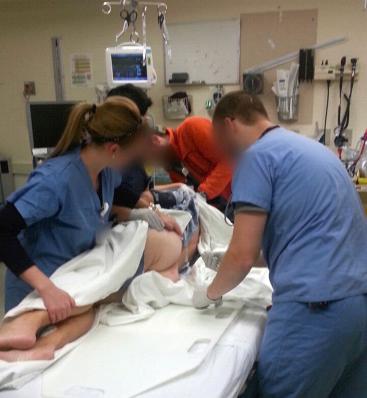
If the patient is responsive and hemodynamically stable, motor and sensory testing should be performed and recorded in the medical record. The American Spinal Injury Association (ASIA) neurologic classification of SCI and the ASIA impairment scale (modified from the Frankel classification ) are useful tools for precisely mapping motor and sensory deficits to a specific spinal cord level ( Fig. 11.2 and Table 11.2 ). Motor strength is tested bilaterally in each of five upper extremity muscle groups ( Fig. 11.3 ) and five lower extremity muscle groups ( Fig. 11.4 ) and graded on the Medical Research Council (MRC) scale from 0 to 5. Sensation is tested bilaterally in each of the sensory dermatomes. The integrity of the lower sacral segments is determined by rectal examination. Perianal sensation is tested and rectal tone assessed by digital examination. The bulbocavernosus reflex is tested by squeezing the glans penis/clitoris or tugging on an indwelling Foley catheter and evaluating contraction of the anal sphincter ( Fig. 11.5 ). The anal wink reflex is mediated by the S2 to S4 nerve roots and is elicited by stroking the skin around the anal sphincter and watching for its contraction. These reflexes are abnormal if no sphincter contraction is observed ( Fig. 11.6 ). Priapism is a sign of spinal cord injury. Deep tendon reflexes and pathologic reflexes are systematically assessed. Fig. 11.7 illustrates the locations of the upper and lower extremity stretch reflexes and the responsible nerve roots. Other important reflexes include clonus and the plantar reflex. The plantar reflex is tested by firmly stroking the plantar aspect of the foot with a pointed object and observing toe movement. Flexion of the toes is normal, but extension of the great toe with splaying of the lesser toes is abnormal (“Babinski sign”) and indicates an upper motor neuron lesion. Craniocervical injuries may be associated with injuries to the cranial nerves, and therefore a complete cranial nerve examination should be performed.
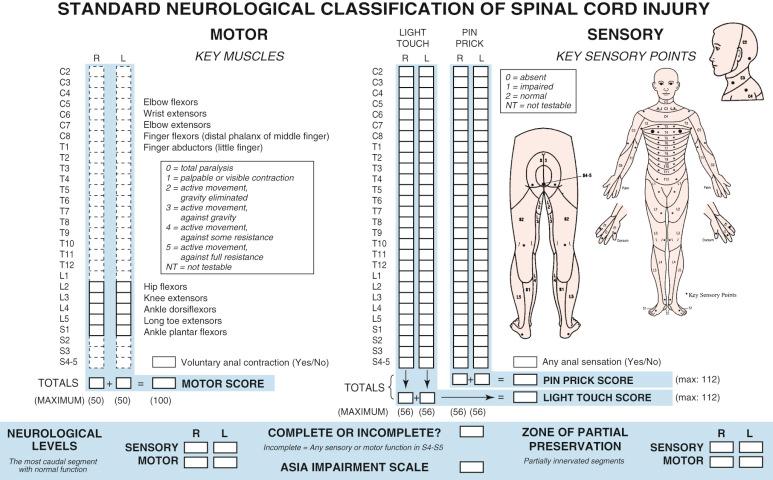
| Category | Characteristics |
|---|---|
| A | Complete: No sensory or motor function is preserved below the neurologic level, including in the lowest sacral segment (S4–S5). |
| B | Incomplete: Sensory but no motor function is preserved below the neurologic level and includes S4–S5. |
| C | Incomplete: Motor function is preserved below the neurologic level, and more than half of the key muscles below the neurologic level have a grade of 0–2. |
| D | Incomplete: Motor function is preserved below the neurologic level, and more than half of the key muscles below the neurologic level have a grade of 3–5. |
| E | Normal sensory and motor function |
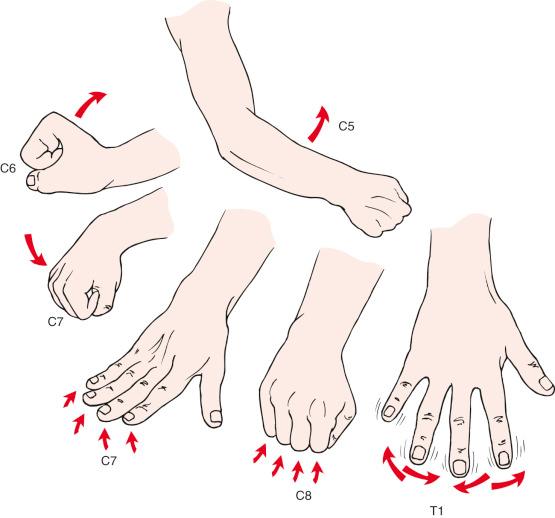
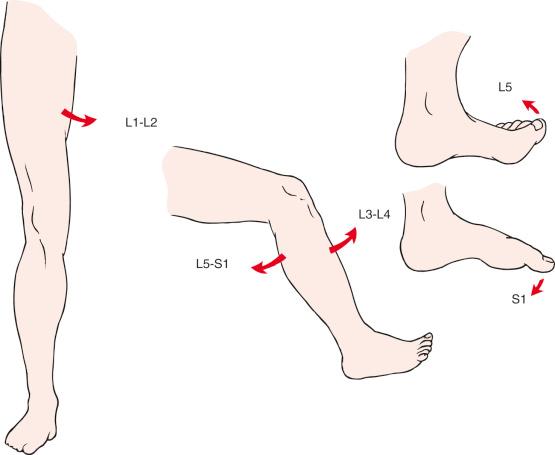
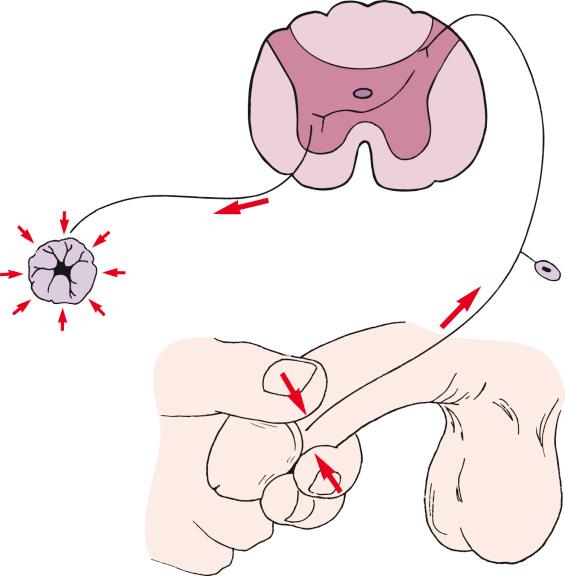
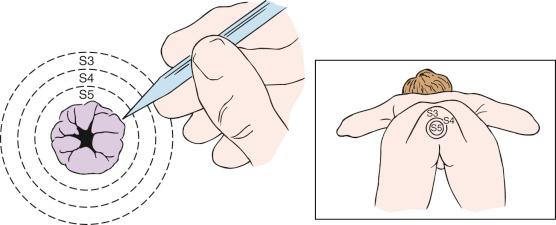
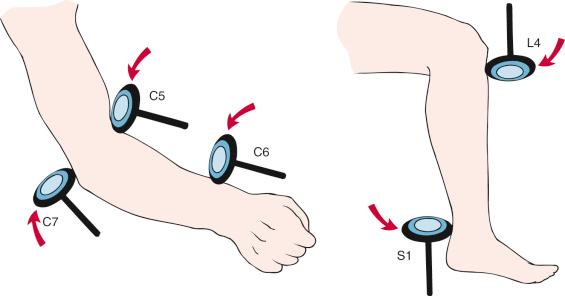
According to ASIA criteria, the “neurologic level” in SCI is the most distal level of the spinal cord with normal motor and sensory function bilaterally. A “complete injury” (ASIA A) is one in which there is a complete absence of motor and sensory function below the specified neurologic injury level, including the lowest sacral segment (S4 to S5) (see Table 11.2 ). Normal sensation at these levels involves sensation in the perineum (see Fig. 11.6 ) and deep anal sensation; normal sacral motor function requires the voluntary contraction of the external anal sphincter. “Incomplete injuries” (ASIA B–D) have partial preservation of sensory or motor function in the lower sacral segments and are associated with a greater potential for some neurologic recovery (see Table 11.2 ). It is important to note that the ASIA standards are not necessarily reliable within 72 hours of injury.
The examination is considered unreliable if the patient is intoxicated, obtunded, or in spinal shock. If the patient is intoxicated or unresponsive, the initial neurologic assessment involves gathering information from the first responders regarding observed neurologic function (i.e., witnessed voluntary extremity motion) at the scene and in transport. Careful observation of spontaneous movements and response to noxious stimuli, reflexes, and rectal tone can give some information about spinal cord function in these patients. In a patient with no identifiable voluntary movement or response to noxious stimuli, the presence of reflex arcs indicates an upper motor neuron injury; their diminution or absence implies spinal shock or a lower motor neuron injury.
Patients may also present in spinal shock, which is the transient physiologic depression in spinal cord function caudal to the level of injury. This is differentiated from neurogenic shock, which is the hemodynamic manifestation of SCI. Neurophysiologists attribute spinal shock to a loss of afferent input into the reflex arcs. The phenomenon usually results in 24 to 72 hours of paralysis, diminished tone, loss of sensation, and absence of reflexes caudal to the injury level. Spinal shock is essential to recognize because it muddles the physical examination and determination of SCI level in the acute setting. The return of spinal reflexes below the level of injury represents the end of spinal shock. Ko et al. observed the return of spinal reflexes in the following order: deep plantar, bulbocavernosus, cremaster, Achilles, Babinski, patellar. The caudal location of the bulbocavernosus reflex (S2 to S4) makes it particularly useful for evaluating spinal shock, especially in the trauma setting. It is important to emphasize that an injury below the spinal cord terminus will not cause spinal shock. For example, a lumbar burst fracture below the level of the spinal cord may cause a conus or cauda equina syndrome, including absent anal sphincter function, but not spinal shock. Irrespective of neurologic function, it is essential to systematically repeat the neurologic assessment to observe changes over time, especially if the patient presents with altered level of consciousness.
Radiographic examination remains an integral part of the initial polytrauma workup; however, this should not interfere with patient resuscitation. If the patient is alert, cooperative, and sober and there are no “distracting injuries,” the decision for radiographic evaluation is dependent on positive physical examination findings. The absence of a reliable examination substantially lowers the threshold to obtain screening imaging.
Two plain radiographs are consistently obtained in the trauma bay primarily to assess for life-threatening injuries. These two radiographs are an anteroposterior (AP) view of the chest and pelvis. The AP chest, in addition to evaluation of the cardiac shadow and the lung fields, can identify subtle thoracic spine injuries. Special attention should be paid to vertebral body heights and their endplates, as well as the location and alignment of the spinous processes and pedicles. The AP pelvis can identify unstable pelvic injuries and help predict potential blood loss. Importantly, part of the lumbar spine and lumbosacral junction will also be visible and should be studied for any anomalies.
The decision to proceed with spine imaging is made after a comprehensive history and trauma evaluation of the patient is performed. A computed tomography (CT) scan with sagittal and coronal plane reformations has become the primary screening tool. Flexion/extension (F/E) plain films are not recommended in the acute setting because they rarely detect pathologic motion in the acute setting and often do not adequately visualize the junctions, which account for up to 15% of cervical injuries. Evaluation of the cervical spine with CT avoids the difficulty of visualizing the occipitocervical junction and cervicothoracic junction experienced with plain radiographs. Notably, inadequate visualization has been reported as being responsible for 94% of errors leading to missed or delayed diagnosis of cervical spine injuries. Furthermore, the false-negative rate of plain spine films has been reported as high as 30%, 52%, and 14%, for cervical, thoracic, and lumbar spine injuries, respectively. Even with technically adequate plain radiographs, their sensitivity overall is only 52%, and up to 61% of injuries can be missed. CT not only provides better spatial characterization of osseous injuries but also aids in preoperative planning, if needed. A recent retrospective review of 3537 trauma patients found that helical multidetector CT (MDCT) identified 99.3% of all fractures of the cervical, thoracic, and lumbar spine. In light of the sensitivity of CT for detecting cervical spine injury, the Eastern Association of Surgery for Trauma (EAST) recommends CT as the primary screening modality.
In general, as long as a patient is stable from a hemodynamic perspective, high-energy polytrauma patients often get “pan-scanned” (including CT of the head, neck, chest, abdomen, and pelvis). The move to scan trauma patients in such fashion has been aided by the advent of modern low-dose CT scanners, which alleviates historical objections related to radiation dose. For a hemodynamically unstable patient, a technically well-performed lateral view of the cervical spine that clearly shows the occipitocervical junction and the cervicothoracic junction may be sufficient initial screening to enable a patient to be taken to the operating room (OR) as long as proper spinal precautions and rigid cervical orthosis are maintained. If significant malalignment is found, Gardner-Wells tongs can be placed and traction applied during the resuscitation period, followed by further imaging and treatment after the patient is stabilized. As a result, the only time a plain lateral cervical spine radiograph should be obtained in the trauma bay is in a trauma patient in extremis who is going to the OR immediately for hemorrhage control.
Although CT is tailored for detecting osseous injury, it is not as sensitive or as accurate for detecting soft tissue injuries. In addition, CT scans are obtained with the patient supine, thus eliminating the effects of physiologic loading. Magnetic resonance imaging (MRI) is the most sensitive imaging modality for evaluating soft tissues, including neural elements, ligaments, zygoapophyseal joint capsules, and intervertebral disks, all without using ionizing radiation. That being said, not every trauma patient requires an MRI. In a prospective study of patients with isolated cervical spine fractures, MRI findings did not change the treatment plan for neurologically intact patients, but it did alter the treatment plan in 25% of patients with a neurologic deficit. Given the financial cost and time needed to acquire the study, MRI is not an ideal modality to screen for spinal injuries during the acute assessment and resuscitation. The role of MRI in clearing the cervical spine is discussed in a later section of the chapter. Regardless of imaging modality, if one finds an injury at one vertebral level, the entire spine needs to be imaged to evaluate for noncontiguous spinal injuries. The reported incidence of noncontiguous spinal fractures is between 3% and 16% in adult patients and 7% in pediatric patients.
Become a Clinical Tree membership for Full access and enjoy Unlimited articles
If you are a member. Log in here